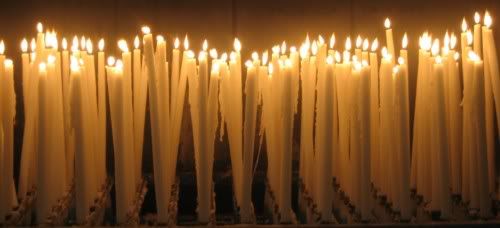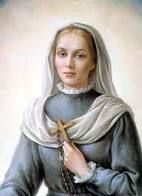"I can't go to bed with a quiet conscience if during the day I've missed any chance, however slight, of preventing wrongdoing or of helping to bring about some good."
Today, December 15, we celebrate the feast day of Saint Maria Crocifissa Di Rosa (1813-1855), Foundress of the Handmaids of Charity, tireless servant to those in need, and profound example of Christian charity.
Born Paula Francesca Maria Di Rosa was born in Brescia Italy, one of nine children of a spinning mill owner and countess. Maria was raised in the Catholic faith, and of her siblings, demonstrated the greatest interest and calling to the Lord. A well-balanced and normal childhood, the family spent happy times together, and religious devotions were a significant part of the time they spent together. When Paula was just ten years old, her mother died, but little changed in the household due to well-established routines. A nearby convent of Visitandine nuns undertook the education and instruction of Paula and her sisters, teaching them the Catechism, sewing, music, poetry, manners, and devotions.
Paula left school at age 17 to assist her father in managing his estate, including the household and servants. Paula began aspiring to religious vocation, and invited her confessor, Monsignor Faustino Pinzoni, frequently to dinner. Similarly, she refused the hands of many suitors her father arranged for her, causing him concern. He wished to see his daughter married, not entering the convent, but was persuaded by the monsignor to stop pressuring her to marry.
Paula was restless in her household chores, seeing suffering and charitable need everywhere around her in Brescia. She told her sisters, “I suffer from seeing suffering,” and set about trying to improve the plight of those in need. Paula first turned her attention to the workers in her father’s mills and the other factories of town. She especially cared for and offered assistance to the young women who were forced by financial circumstances to work long-hours in difficult conditions. Her father encouraged Paula to attend to the spiritual and material needs of his underpaid workers. She further spent long hours visiting local hospitals, ministering to the sick—especially those that no one else would help. During the cholera epidemic of 1836, Paula slept only a few hours each night, running herself into exhaustion helping others.
At the age of 27, Paula decided that she needed to be a bit more organized in her charitable efforts. She was concerned with the lives of the factory workers after they left their jobs, as many of the young were living in unsafe conditions and were easily targeted and victimized. Together with a wealthy widow, Gabriela Bornati, she founded the society of Handmaids of Charity. The sole purpose of the Handmaids was to minister to the material needs of those afflicted by poverty or disease. Her first act was to found a home dedicated to the spiritual needs of the young women she cared for, and a school for deaf children. Forsaking luxury, she lived in a tiny shack by the hospital, caring for the ill on a daily basis.
Her father, for his part, while still wishing to see her married, was concerned with her living conditions. He offered a house to the women, which they accepted. Gabriela died there some three years later, but not before the Handmaids of Charity had established a solid presence throughout the region. In 1840, Paula became the superior of the Order, taking the name Maria Crocifissa. The local bishop offered approval of the order, followed by papal approval in 1850.
In 1852, when war broke out in the region, the Handmaids cared for the soldiers of both sides, seeing God’s people regardless of nationality. They worked throughout the war, being recognized for their courage in defending their patients in the hospitals by blocking doorways to wards with crucifixes and lighted candles, and ministering to the wounded and dying on the battlefields. Soon after the war, a second cholera epidemic pushed the growing order to its limit—with the tired and dedicated sisters working in schools, orphanages, and hospitals.
Maria, worn out from her tireless work, found herself in the hospital at the age of 42. She never recovered, and died after a selfless lifetime of service to those in need.
Saint Maria, you weren't afraid to take new opportunities. It's frightening when we are asked to do something that is different or new. We would rather stay in our safe and comfortable routines. Help us to embrace each obstacle in our path as a new opportunity to serve God. Amen.
Year 2: Day 349 of 365
Prayer Intentions: Tireless hearts of service and charity.
Requested Intentions: Financial security, successful employment (J); Obedience to God’s will (A); Conversion of souls (A); Success of business venture; faith of daughter (S); Safe return home (J); Recovery of mother and son; repose of the souls of the dearly departed (A); Blessings upon a relationship (M); Sobriety and recovery for a son (M); Employment and successful marriage (A); Employment, healing, freedom from anxiety (T); Financial security (C); Conversion (T); Peace in difficult times at work (E); Financial security and blessings for mother and children (T); Financial security for a mother (M); Health, finances, successful marriage (A); Successful resolution of court case for son (K); Continued sobriety (N); Healing of a chronic health condition (B); Successful employment (A): Peace in a family, recovery of a niece from substance use (L); Blessings on a marriage, healing of a husband (P); For the health and recovery of sisters (B); For a daughter and granddaughter (D); Blessings on overseas employment (M); Healing of mother (L).
Why pray the Rosary every day for a year?
Each time the Blessed Virgin has appeared-- whether it be to Saint Bernadette Soubirous at Lourdes; to Lucia, Jacinta, and Francisco at Fatima; or to Mariette Beco at Banneux-- she has asserted the importance, saving grace, and power of praying the Holy Rosary on a daily basis. Based upon her words, the Rosary is penance and conversion for sinners, a pathway to peace, an end to war, and a powerful act of faith in Jesus Christ. Pope Paul VI presented the Rosary as a powerful means to reach Christ "not merely with Mary but indeed, insofar as this is possible to us, in the same way as Mary, who is certainly the one who thought about Him more than anyone else has ever done."
To show us how this is done, perhaps no one has been more eloquent than the great Cardinal Newman, who wrote: "The great power of the Rosary consists in the fact that it translates the Creed into Prayer. Of course, the Creed is already in a certain sense a prayer and a great act of homage towards God, but the Rosary brings us to meditate again on the great truth of His life and death, and brings this truth close to our hearts. Even Christians, although they know God, usually fear rather than love Him. The strength of the Rosary lies in the particular manner in which it considers these mysteries, since all our thinking about Christ is intertwined with the thought of His Mother, in the relations between Mother and Son; the Holy Family is presented to us, the home in which God lived His infinite love."
As Mary said at Fatima, "Jesus wants to use you to make Me known and loved. He wishes to establish the devotion to My Immaculate Heart throughout the world. I promise salvation to whoever embraces it; these souls will be dear to God, like flowers put by Me to adorn his throne."

Subscribe to:
Post Comments (Atom)











0 comments:
Post a Comment
Thanks for leaving a comment. If you wish to submit a prayer request, however, please do so above, using the "Contact" tab.